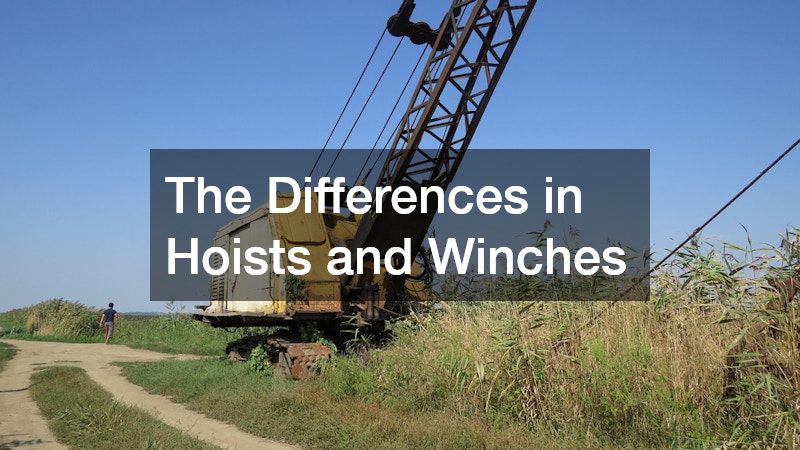Hoists and winches are both essential pieces of equipment in industries such as construction, manufacturing, and shipping, where lifting and moving heavy loads are routine tasks. While they share some similarities in their basic functions—both are used to move or lift items—they are designed for different types of tasks and have distinct mechanisms of operation. Understanding the differences between hoists and winches is essential for choosing the right equipment for a specific application. In this article, we will explore the primary distinctions between hoists and winches, including their mechanisms, uses, and advantages.
A hoist is a mechanical device used to lift or lower heavy loads vertically. It consists of a drum, rope or chain, and a lifting mechanism such as a hook or trolley. Hoists are typically powered by electricity, hydraulics, or manual force and are designed for lifting objects directly upward or downward. They are often used in applications such as lifting heavy materials in warehouses, construction sites, or industrial environments. Hoists are equipped with safety mechanisms to prevent overloads and to ensure smooth, controlled lifting.
In contrast, a winch is primarily used to pull or haul heavy loads horizontally or along a surface. Winches are typically used in situations where lifting is not required, but rather the movement of loads from one point to another. A winch consists of a spool (or drum) of cable or rope, a motor or manual mechanism for winding the cable, and a hook or attachment point for securing the load. Winches are commonly found in applications such as towing, rescue operations, and pulling vehicles or equipment over rough terrain.
One of the key differences between hoists and winches lies in the direction of movement. Hoists are designed for vertical lifting, making them ideal for tasks such as raising heavy items to a higher level, such as lifting a load to a crane or moving objects up to upper floors of a building. Winches, on the other hand, are designed for horizontal pulling, which is useful for tasks like pulling boats onto trailers, hauling equipment across a flat surface, or dragging heavy items through tough conditions.
Another notable difference between hoists and winches is their power source and design. Hoists are usually powered by electricity, hydraulics, or compressed air, depending on the application. Electric hoists are commonly used in industrial settings where high lifting capacities and efficiency are required. Manual hoists, like chain blocks or lever hoists, are used for smaller tasks or in locations without access to electrical power. Winches can be powered by electricity, hydraulics, or internal combustion engines, with manual winches also available for smaller or more portable tasks.
Lifting capacity is another area where hoists and winches differ. Hoists are generally designed to handle heavier loads vertically. They are often rated by their lifting capacity, which can range from a few hundred pounds to several tons, depending on the design and application. This makes hoists ideal for lifting heavy industrial machinery, construction materials, or even vehicles. Winches, while capable of handling heavy loads, are typically designed to pull rather than lift and are often used in situations where the load is not as heavy or the weight distribution is less critical. For example, winches are used in towing operations, where the load is pulled across a flat surface, reducing the strain on the winch compared to a hoist lifting a heavy load vertically.
Applications for hoists and winches also highlight their distinct roles in various industries. Hoists are frequently used in environments such as factories, warehouses, and construction sites where materials need to be lifted and moved vertically. They are used to move materials from one floor to another or to lift heavy machinery into place. Winches, on the other hand, are often employed in construction and marine industries, where their pulling capabilities are needed for tasks like dragging equipment, pulling vehicles, or pulling boats onto docks. They are also common in rescue operations, where they can pull stranded vehicles or people to safety.
In terms of safety features, both hoists and winches are designed with mechanisms to ensure safe operation. Hoists typically include features like overload limiters, emergency stops, and limit switches that prevent the hoist from lifting more than its rated capacity. Winches, particularly those used in towing and rescue, often include braking systems to prevent the load from moving unexpectedly when the winch is not actively pulling. Both types of equipment should be regularly inspected and maintained to ensure that these safety features function properly and that the equipment operates efficiently.
In conclusion, while hoists and winches share some similarities in that they both move heavy loads, their mechanisms, applications, and functions are distinctly different. Hoists are primarily designed for vertical lifting, whereas winches are used for horizontal pulling. Hoists typically have a higher lifting capacity and are used in industrial settings for moving materials vertically, while winches are often employed in tasks like towing or pulling equipment across a surface. Understanding the differences between hoists and winches allows operators to select the right equipment for the job, ensuring safe and efficient operations in a variety of industries. Whether for lifting or pulling, both hoists and winches are indispensable tools that play crucial roles in heavy-duty applications.
.







